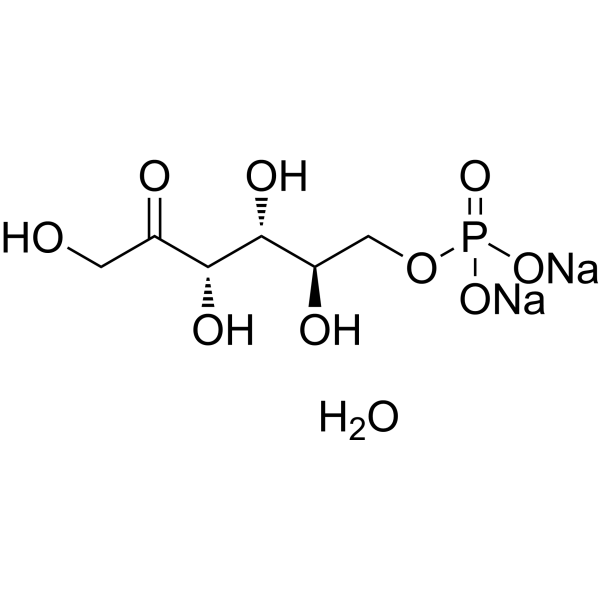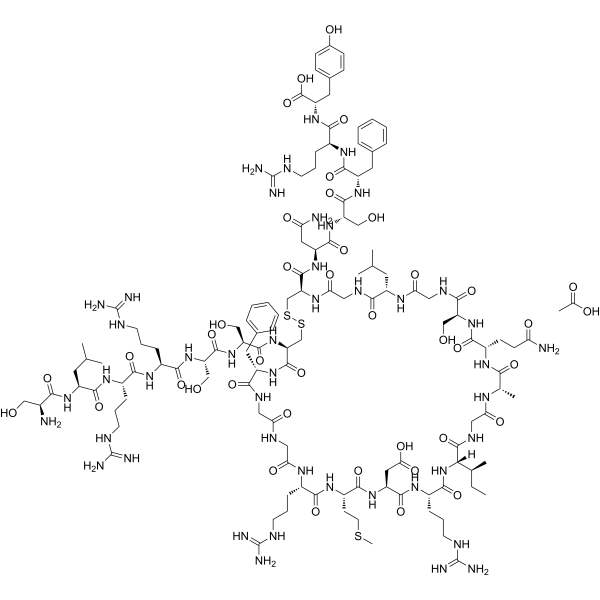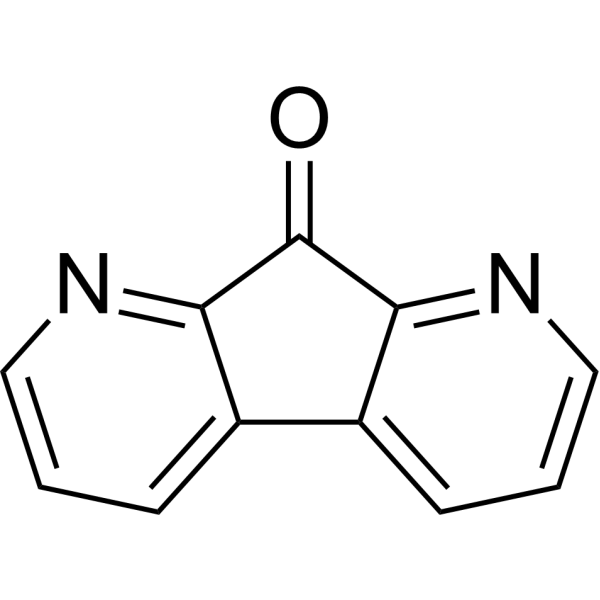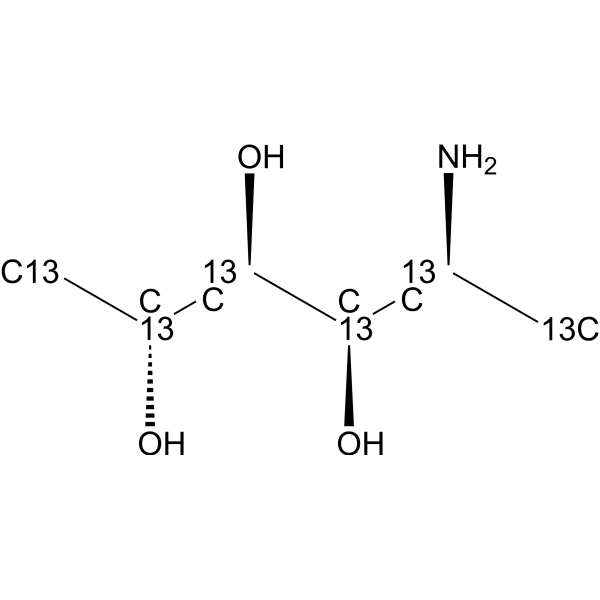- Anti-infection
- Antibody-drug Conjugate/ADC Related
- Apoptosis
- Autophagy
- Cell Cycle/DNA Damage
- Cytoskeleton
- Epigenetics
- GPCR/G Protein
- Immunology/Inflammation
- JAK/STAT Signaling
- MAPK/ERK Pathway
- Membrane Transporter/Ion Channel
- Metabolic Enzyme/Protease
- Neuronal Signaling
- NF-κB
- PI3K/Akt/mTOR
- PROTAC
- Protein Tyrosine Kinase/RTK
- Stem Cell/Wnt
- TGF-beta/Smad
- Vitamin D Related/Nuclear Receptor
- Others
Anti-infection
Apoptosis
Cell Cycle/DNA Damage
Cytoskeleton
Epigenetics
GPCR/G Protein
- 5-HT Receptor
- Adenylate Cyclase
- Adhesion G Protein-coupled Receptors (AGPCRs)
- Adrenergic Receptor
- Amylin Receptor
- Angiotensin Receptor
- Apelin Receptor (APJ)
- Arf Family GTPase
- Arrestin
- Bombesin Receptor
- Bradykinin Receptor
- Cannabinoid Receptor
- CaSR
- CCR
- CGRP Receptor
- Chemerin Receptor
- Cholecystokinin Receptor
- CRFR
- CXCR
- EBI2/GPR183
Immunology/Inflammation
Membrane Transporter/Ion Channel
Metabolic Enzyme/Protease
- 11β-HSD
- 15-PGDH
- 17β-HSD
- 3β-HSD
- 5 alpha Reductase
- Acetolactate Synthase (ALS)
- Acetyl-CoA Carboxylase
- Acetyl-CoA synthetase
- Acyltransferase
- ADAMTS
- Adiponectin Receptor
- Aldehyde Dehydrogenase (ALDH)
- Aldehyde Oxidase (AO)
- Aldose Reductase
- Amine N-methyltransferase
- Amino Acid Oxidase
- Aminoacyl-tRNA Synthetase
- Aminopeptidase
- Aminotransferases (Transaminases)
- Amylases
Neuronal Signaling
- 5-HT Receptor
- AAK1
- Adrenergic Receptor
- Amino Acid Decarboxylase
- Amyloid-β
- Beta-secretase
- Calcineurin
- Calcium Channel
- CaMK
- Cannabinoid Receptor
- CGRP Receptor
- Cholecystokinin Receptor
- Choline Kinase
- Cholinesterase (ChE)
- COMT
- Dihydroceramide Desaturase 1 (DES1)
- Dimethylargininase (DDAH)
- FAAH
- GABA Receptor
- Glucosylceramide Synthase (GCS)
Protein Tyrosine Kinase/RTK
Stem Cell/Wnt
- Compound Screening Libraries
- Bioactive Screening Libraries
- •Bioactive Compound Library
- Drug Repurposing Series
- •FDA-Approved Drug Library
- •Drug Repurposing Compound Library
- Natural Products Series
- •Natural Product Library
- •Natural Product-like Compound Library
- Metabolism Series
- •Human Endogenous Metabolite Compound Library
- Disease Related Compound Libraries
- Signaling Pathway Series
- Fragment Libraries
- Diversity Compound Libraries
- •50K Diversity Library
- •5K Scaffold Library
- •3D Diverse Fragment Library
- Virtual Screening
- •50K Virtual Diversity Library
- •10M Virtual Diversity Library
- Recombinant Proteins
- Cytokines and Growth Factors
- Immune Checkpoint Proteins
- CAR-T Related Proteins
- CD Antigens
- Fc Receptors
- Receptor Proteins
- Enzymes & Regulators
- Complement System
- Ubiquitin Related Proteins
- Viral Proteins
- Biotinylated Proteins
- Fluorescent-labeled Recombinant Proteins
- GMP-grade Proteins
- Animal-free Recombinant Proteins
- Protein Expression Service
- Custom Synthesis Service
- ADC-Related Custom Services
- PROTAC-Related Custom Services
- Cytokines and Growth Factors
- Immune Checkpoint Proteins
- CAR-T Related Proteins
- CD Antigens
- Fc Receptors
- Receptor Proteins
- Enzymes & Regulators
- Complement System
- Ubiquitin Related Proteins
- Viral Proteins
- Biotinylated Proteins
- Fluorescent-labeled Recombinant Proteins
- GMP-grade Proteins
- Animal-free Recombinant Proteins
- Others
- View More
CAR-T Related Proteins
- CD27 Ligand/CD70
- CD4
- CD19
- CD27 Ligand/CD70
- CD123
- CD138/Syndecan-1
- Epithelial Cell Adhesion Molecule (EpCAM)
- Folate Receptor 1
- GPC-3
- Guanylate Cyclase 2C
- ErbB2/HER2
- ErbB3/HER3
- c-Met/HGFR
- MSLN
- CA-125
- ROR1
- CEACAM-5
- CD314/NKG2D
- Prostate Specific Membrane Antigen
- CD319/SLAMF7
- TROP-2
- Siglec-6
- Folate Receptor alpha (FR-alpha)
- CD314/NKG2D
- Siglec-3/CD33
- CD27 Ligand/CD70
- CD319/SLAMF7
- ErbB2/HER2
- Siglec-3/CD33
- CD7
- MUC-1/CD227
CD Antigens
- T Cell CD Proteins
- B Cell CD Proteins
- NK Cell CD Proteins
- Macrophage CD Proteins
- Monocyte CD Proteins
- Stem Cell CD Proteins
- Platelet CD Proteins
- Erythrocyte CD Proteins
- Dendritic Cell CD Proteins
- Epithelial cell CD Proteins
- Endothelial cell CD Proteins
- Signal Transduction-related CD Proteins
- Cell Adhesion-related CD Proteins
Receptor Proteins
- Receptor Tyrosine Kinases
- Receptor Serine/Threonine Kinases
- Receptor Tyrosine Phosphatase
- Receptor Guanylyl Cyclase Family
- Cell Adhesion Molecules (CAMs)
- G-Protein-Coupled Receptors (GPCRs)
- Nuclear Receptor Superfamily
- Pattern Recognition Receptors
- Notch family
- Siglec
- Leukocyte Immunoglobin-like Receptors
- Killer-Cell Immunoglobulin-like Receptors
- Cytokine Receptors
Enzymes & Regulators
- Oxidoreductases (EC 1)
- Transferases (EC 2)
- Hydrolases (EC 3)
- Lyases (EC 4)
- Isomerases (EC 5)
- Ligases (EC 6)
- Translocases (EC 7)
- Matrix Metalloproteinases
- ADAMs/ADAMTSs
- Cathepsin
- Carboxypeptidase
- Angiotensin-converting Enzymes
- Caspase
- Carbonic Anhydrase
- Serine/Threonine Kinase Proteins
- Protein Tyrosine Kinases
- Phosphatase
- Topoisomerase
- Protease Inhibitors
- Protein Kinase Inhibitor Peptide (PKI)
- Cyclin-Dependent Kinase Inhibitor Proteins
- Cystatin Family
- Molecular Biology
- •Nucleic Acid Gel Electrophoresis
- •Vector Construction
- •Restriction Endonuclease
- •Materials
- •PCR & qPCR
- •RT-PCR
- •Sequencing
- Protein Biology
- •Protein Sample Preparation
- •Protein Purification
- •Protein Electrophoresis & WB
- •Multiple Fluorescent Staining
- •Immunoassay
- •Immunoprecipitation Kit
- •Labeling Kit
- Cell Biology
- •Cell Culture
- •Cell Analysis
- •3D Cell Culture
- •Cell Isolation
- View More
Cell Analysis
- Cell Proliferation and Cytotoxicity
- Reporter Gene Testing
- Phalloidin Dye Conjugates
- Cell Apoptosis and Necrosis
- AntiFade Mounting Medium
- Mitochondrial Isolation
- Exosome Isolation, Purification and Detection
- Organelle Research
- Metabolism Assay Kit
- Mycoplasma Detection
- Biochemical Assay Kit
- Endotoxin Detection
- Quality Management System
- Custom Synthesis Service
- Bulk and Custom Synthesis Service
- ADC-Related Custom Services
- PROTAC-Related Custom Services
- Custom Reference Standard Products
- Custom Peptide Synthesis
- Protein Expression Service
- Recombinant Antibody Expression Service
- Protein Crystal Structure Elucidation
- Oligonucleotide Synthesis
- Gene Regulation Tool
- • Lentivirus Packaging
- • Adenovirus Packaging
- Fluorescent Labeling Service
- Custom Synthesis of Stable Isotope-Labeled Compounds
- One-stop CDMO Service
- One-stop Compound Screening Platform
- Virtual Screening
- Molecular Dynamics Simulation
- Cell-based Compound Screening
- Ion Channel Screening
- Kinase Screening Service
- SPR Assay Service
- GPCR Bioassay Screening Services
- Nuclear Receptor Screening Services
- Affinity Mass Spectrometry
- DEL Synthesis and Screening
- Molecular Interaction Assay Service
- Drug Target Identification Service
- AI Driven Drug Screening
- Molarity Calculator
- Dilution Calculator
































































































































































































































































![(S)-2-Amino-3-(benzo[b]thiophen-3-yl)propanoic acid](http://file.medchemexpress.eu/product_pic/hy-w022796.gif)








acetic acid](http://file.medchemexpress.eu/product_pic/hy-78105.gif)


































![(αR)-α-[[(1,1-Dimethylethoxy)carbonyl]amino]benzeneacetic acid](http://file.medchemexpress.eu/product_pic/hy-34663.gif)































![N-[2-(Fmoc-amino)-ethyl]-Gly-O-tBu hydrochloride](http://file.medchemexpress.eu/product_pic/hy-w141923.gif)

































![S-[2-[[4-[(3-Aminopropyl)amino]butyl]amino]-2-oxoethyl]-CoA](http://file.medchemexpress.eu/product_pic/hy-ce01649.gif)













![(S)-2-[(tert-Butoxycarbonyl)amino]-3-iodopropionic acid methyl ester](http://file.medchemexpress.eu/product_pic/hy-z0424.gif)













![(αS)-α-[[(9H-Fluoren-9-ylmethoxy)carbonyl]amino]-2-pyridinepropanoic acid](http://file.medchemexpress.eu/product_pic/hy-34540.gif)
![(2S)-4-(Benzyloxy)-2-[(tert-butoxycarbonyl)amino]-4-oxobutanoic acid (Standard)](http://file.medchemexpress.eu/product_pic/hy-z0615r.gif)


















![(2S)-2-[(tert-Butoxycarbonyl)amino]-3-(3-fluorophenyl)propionic acid](http://file.medchemexpress.eu/product_pic/hy-79288.gif)








































![D-[(Amino)Carbonyl]Phenylalanine-CoA](http://file.medchemexpress.eu/product_pic/hy-ce01308.gif)
















![(2R)-2-[(3,5-Dinitrobenzoyl)amino]-2-phenyl-acetic acid](http://file.medchemexpress.eu/product_pic/hy-w125501.gif)
![(2S)-2-[(tert-Butoxycarbonyl)amino]-3-(3,4-difluorophenyl)propionic acid](http://file.medchemexpress.eu/product_pic/hy-79165.gif)


































































![N-[Amino(Imino)methyl]glycine-CoA](http://file.medchemexpress.eu/product_pic/hy-ce01603.gif)
















































































































![(2S)-4-(Benzyloxy)-2-[(tert-butoxycarbonyl)amino]-4-oxobutanoic acid](http://file.medchemexpress.eu/product_pic/hy-z0615.gif)


















































![(2S)-4-(benzyloxy)-2-{[(9H-fluoren-9-ylmethoxy)carbonyl]amino}-4-oxobutanoic acid](http://file.medchemexpress.eu/product_pic/hy-w002301.gif)








































































































































amino]-3-methylbutanoic acid](http://file.medchemexpress.eu/product_pic/hy-41051.gif)






![2-Amino-3-Methylimidazo[4,5-f]quinoxaline-d3](http://file.medchemexpress.eu/product_pic/hy-w701060.gif)
























![2-[Methyl(nitroso)amino]acetic acid-d3](http://file.medchemexpress.eu/product_pic/hy-w188178s.gif)




![cis-4-[Bis(phenylmethyl)amino]cyclohexanemethanol (Standard)](http://file.medchemexpress.eu/product_pic/hy-z0694r.gif)
![trans-4-[Bis(phenylmethyl)amino]cyclohexanecarboxylic acid (Standard)](http://file.medchemexpress.eu/product_pic/hy-z0691r.gif)








































![cis-4-[Bis(phenylmethyl)amino]cyclohexanemethanol](http://file.medchemexpress.eu/product_pic/hy-z0694.gif)
![trans-4-[Bis(phenylmethyl)amino]cyclohexanecarboxylic acid](http://file.medchemexpress.eu/product_pic/hy-z0691.gif)





















![[R-(Z)]-4-Amino-3-chloro-2-pen-tenedioicacid](http://file.medchemexpress.eu/product_pic/hy-n14921.gif)







![2-Amino-3,4,8-trimethylimidazo[4,5-f]quinoxaline-d3](http://file.medchemexpress.eu/product_pic/hy-w700103.gif)








![5-[Boc(methyl)amino]pentanal](http://file.medchemexpress.eu/product_pic/hy-138520.gif)














![2-[(4-Methyl-2-nitrophenyl)amino]ethanol (Standard)](http://file.medchemexpress.eu/product_pic/hy-w152326r.gif)



















![Lactalbumin B (50-53) Alpha [Lactorphin Alpha], bovine](http://file.medchemexpress.eu/product_pic/hy-p3976.gif)

























































![2-Amino-3-methyl-9H-pyrido[2,3-b]indole-d3](http://file.medchemexpress.eu/product_pic/hy-w740023.gif)









![N-[2-[(1-Oxohexadecyl)amino]ethyl]octadecanamide](http://file.medchemexpress.eu/product_pic/hy-155935.gif)

























![3-[(2-Fluoro-4-iodophenyl)amino]isonicotinic acid](http://file.medchemexpress.eu/product_pic/hy-66016.gif)



![Carbonylhydrido(tetrahydroborato)[bis(2-diphenylphosphinoethyl) aMino]ruthenium(II)](http://file.medchemexpress.eu/product_pic/hy-w033559.gif)




















![1-(3,4-Dihydroxyphenyl)-2-[methyl(phenylmethyl)amino]ethanone (Standard)](http://file.medchemexpress.eu/product_pic/hy-w585975r.gif)















![2-[(Azidoacetyl)amino]-2-deoxy-D-glucose, 98%](http://file.medchemexpress.eu/product_pic/hy-w039950.gif)

































![5-[3-[(Trifluoroacetyl)amino]propyl]uridine](http://file.medchemexpress.eu/product_pic/hy-152543.gif)





































![2-[(Azidoacety)amino]-2-deoxy-D-galactose](http://file.medchemexpress.eu/product_pic/hy-w039921.gif)





![1-[4-(Methylthio)phenyl]-2-[(phenylmethyl)amino]-1-propanone hydrochloride](http://file.medchemexpress.eu/product_pic/hy-158913.gif)
![1-[4-(Dimethylamino)phenyl]-2-[(phenylmethyl)amino]-1-propanone hydrochloride](http://file.medchemexpress.eu/product_pic/hy-168836.gif)







![4-Amino-6-bromo-7H-pyrrolo[2,3-d]pyrimidine-5-carbonitrile](http://file.medchemexpress.eu/product_pic/hy-43791.gif)

![2-[(1H-Indol-3-ylcarbonyl)amino]benzoic acid](http://file.medchemexpress.eu/product_pic/hy-n1643.gif)
![N-[[Bis[4-(dimethylamino)phenyl]amino]carbonyl]glycine sodium](http://file.medchemexpress.eu/product_pic/hy-w129500.gif)




![16-[[2-(Methylamino)-2-oxoacetyl]amino]-11Z-hexadecenoic acid](http://file.medchemexpress.eu/product_pic/hy-120500.gif)

![2′-Amino-5′-O-[bis(4-methoxyphenyl)phenylmethyl]-2′-deoxyuridine](http://file.medchemexpress.eu/product_pic/hy-154424.gif)













![2-[(2-Amino-6-oxo-6,9-dihydro-1h-purin-9-yl)methoxy]ethyl acetate (Standard)](http://file.medchemexpress.eu/product_pic/hy-w197969r.gif)


![1-[(2R)-N’-Boc-2-amino-2-cyclohexylacetyl]-N-(4’-cyanobenzyl)-2-L-azetidinecarboxamide-d11](http://file.medchemexpress.eu/product_pic/hy-132728s.gif)
![6-Amino-9-[2-deoxy-β-D-ribofuranosyl]-9H-purine](http://file.medchemexpress.eu/product_pic/hy-154610.gif)















![S-[2-[[2-(1H-Indol-3-yl)ethyl]amino]-2-oxoethyl]-COA](http://file.medchemexpress.eu/product_pic/hy-ce00924.gif)




![2-Ethylbutyl (2S)-2-{[(s)-pentafluorophenoxy(phenoxy)phosphoryl]amino}propanoate (Standard)](http://file.medchemexpress.eu/product_pic/hy-w121908r.gif)













![N3-[3-(tert-Butoxycarbonyl)amino]propyluridine](http://file.medchemexpress.eu/product_pic/hy-154738.gif)













![tert-Butyl (2-((5-chlorobenzo[d]oxazol-2-yl)amino)ethyl)carbamate (Standard)](http://file.medchemexpress.eu/product_pic/hy-77000r.gif)

![(2S,4R)-Ethyl 5-([1,1'-biphenyl]-4-yl)-4-amino-2-methylpentanoate hydrochloride](http://file.medchemexpress.eu/product_pic/hy-78851.gif)























![5-[(Dimethyl-amino)methyl]-2-furanmethanol-d6](http://file.medchemexpress.eu/product_pic/hy-w700730.gif)





![2-(((3aR,4S,6R,6aS)-6-((5-Amino-6-chloro-2-(propylthio)pyrimidin-4-yl)amino)-2,2-dimethyltetrahydro-3aH-cyclopenta[d][1,3]dioxol-4-yl)oxy)ethanol](http://file.medchemexpress.eu/product_pic/hy-78055.gif)













![1-Octylnonyl 8-[[8-[(1-ethylnonyl)oxy]-8-oxooctyl](2-hydroxyethyl)amino]octanoate](http://file.medchemexpress.eu/product_pic/hy-147018.gif)






![5-Amino-1,3-dimethyl-6-(3-propoxyphenoxy)-1H-benzo[d]imidazol-2(3H)-one](http://file.medchemexpress.eu/product_pic/hy-43367.gif)













![(S)-methyl 3-([1,1'-biphenyl]-4-yl)-2-((tert-butoxycarbonyl)amino)propanoate (Standard)](http://file.medchemexpress.eu/product_pic/hy-z0177r.gif)












![(S)-tert-Butyl 2-(3-amino-2-oxo-2,3,4,5-tetrahydro-1H-benzo[b]azepin-1-yl)acetate (Standard)](http://file.medchemexpress.eu/product_pic/hy-50783r.gif)
amino]nonadecanedioate](http://file.medchemexpress.eu/product_pic/hy-134783.gif)
![tert-Butyl (4-(4-amino-3-iodo-1H-pyrazolo[3,4-d]pyrimidin-1-yl)butyl)carbamate](http://file.medchemexpress.eu/product_pic/hy-23483.gif)













![2-Amino-3-methyl-3H-imidazo[4,5-f]quinoline-d3](http://file.medchemexpress.eu/product_pic/hy-w706319.gif)




![4-(2-(2-Amino-4-oxo-4,7-dihydro-1H-pyrrolo[2,3-d]pyrimidin-5-yl)ethyl)benzoic acid (Standard)](http://file.medchemexpress.eu/product_pic/hy-w074376r.gif)











![6-Amino-4-hydrozino-2-(β-D-ribofuranosyl)-2H-pyrazolo[3,4-d]pyrimidine](http://file.medchemexpress.eu/product_pic/hy-152410.gif)

![6-Amino-4-hydroxyamino-2-(β-D-ribofuranosyl)-2H-pyrazolo[3,4-d]pyrimidine](http://file.medchemexpress.eu/product_pic/hy-152414.gif)
![4-Amino-1-(β-D-ribofuranosyl)-7H-pyrrolo[2.3-d]pyrimidine-5-carboxamide](http://file.medchemexpress.eu/product_pic/hy-152685.gif)
![6-Amino-4-methoxy-2-(β-D-ribofuranosyl)-2H-pyrazolo[3,4-d]pyrimidine](http://file.medchemexpress.eu/product_pic/hy-152398.gif)








![6-Amino-3-ethynyl-4-methoxy-1-(β-D-ribofuranosyl)-1H-pyrazolo[3,4-d]pyrimidine](http://file.medchemexpress.eu/product_pic/hy-152438.gif)









![2-Amino-3-methyl-3H-imidazo[4,5-f]quinoline-2-13C](http://file.medchemexpress.eu/product_pic/hy-w779193.gif)
![5-[3-[(2,2,2-Trifluoroacetyl)amino]-1-propyn-1-yl]uridine](http://file.medchemexpress.eu/product_pic/hy-152580.gif)
![4-Amino-5-cyano-1- (β-D-ribofuranosyl)-7H-pyrrolo[2,3-d] pyrimidine](http://file.medchemexpress.eu/product_pic/hy-152680.gif)










![2’-Deoxy-2’-fluoro-N3-(2S)-(2-amino-3-carbonyl] propyl-beta-D-arabinouridine](http://file.medchemexpress.eu/product_pic/hy-154662.gif)




![(R)-tert-Butyl 3-(4-amino-3-iodo-1H-pyrazolo[3,4-d]pyrimidin-1-yl)piperidine-1-carboxylate](http://file.medchemexpress.eu/product_pic/hy-43029.gif)










![6-Amino-4-methoxy-1-(2-deoxy-a-D-ribofuranosyl)-1H-pyrazolo[3,4-d]pyrimidine](http://file.medchemexpress.eu/product_pic/hy-154122.gif)






![4-Amino-5-cyano-1-(2-deoxy-β-D-ribofuranosyl)-7H-pyrrolo[2,3-d]pyrimidine](http://file.medchemexpress.eu/product_pic/hy-154002.gif)
![6-Amino-4-hydrozino-1-(2-deoxy-β-D-ribofuranosyl)-1H-pyrazolo[3,4-d]pyrimidine](http://file.medchemexpress.eu/product_pic/hy-154047.gif)
![2-Pyridinesulfonamide, N-[[(4,6-dimethoxy-2-pyrimidinyl)amino]carbonyl]-3-(2,2,2-trifluoroethoxy)-d6](http://file.medchemexpress.eu/product_pic/hy-165702s.gif)
![6-Amino-4-methoxy-1-(2-deoxy-β-D-ribofuranosyl)-1H-pyrazolo[3,4-d]pyrimidine](http://file.medchemexpress.eu/product_pic/hy-154008.gif)




![5-[[Methyl(2,2,2-trifluoroacetyl)amino]methyl]-2-thiouridine](http://file.medchemexpress.eu/product_pic/hy-152735.gif)


![(3aR,4S,6R,6aS)-6-Amino-2,2-dimethyltetrahydro-3aH-cyclopenta[d][1,3]dioxol-4-ol (Standard)](http://file.medchemexpress.eu/product_pic/hy-78720r.gif)






![4-Amino-6-bromo-5-cyano-1-(beta-D-ribofuranosyl)-7H-pyrrolo[2.3-d]pyrimidine](http://file.medchemexpress.eu/product_pic/hy-154005.gif)











![[(R)-2-(Phenylphosphonomethoxy)propyl]adenine-d5](http://file.medchemexpress.eu/product_pic/hy-w747167.gif)



![4-Amino-1-(2-C-methyl-β-D-ribofuranosyl)-1H-pyrrolo[2,3-d]pyrimidine-5-carbonitrile](http://file.medchemexpress.eu/product_pic/hy-152718.gif)



![2’-Deoxy-2’-fluoro-N3-[3-(tert-butoxycarbonyl) amino]propyluridine](http://file.medchemexpress.eu/product_pic/hy-154725.gif)









![6-Amino-1,2-dihydro-2-β-D-ribofuranosyl-4H-pyrazolo[3,4-d]pyrimidin-4-one](http://file.medchemexpress.eu/product_pic/hy-152405.gif)




![4-Amino-5-iodo-7-(2-β-C-methyl-β-D-ribofuranosyl)-7H-pyrrolo[2,3-d]pyrimidine](http://file.medchemexpress.eu/product_pic/hy-152819.gif)

![(2S,4R)-5-([1,1'-Biphenyl]-4-yl)-4-((tert-butoxycarbonyl)amino)-2-methylpentanoic acid (Standard)](http://file.medchemexpress.eu/product_pic/hy-78845r.gif)

![(2R,4S)-5-(Biphenyl-4-yl)-4-[(tert-butoxycarbonyl)amino]-2-methylpentanoic acid](http://file.medchemexpress.eu/product_pic/hy-78837.gif)

![2-Deoxy-2-[[(4-methoxyphenyl)methylene]amino]-β-D-glucopyranose](http://file.medchemexpress.eu/product_pic/hy-w354410.gif)



![(S)-(2-Amino-5-methoxy-4-((triisopropylsilyl)oxy)phenyl)(6-(((tert-butyldimethylsilyl)oxy)methyl)-5-azaspiro[2.4]heptan-5-yl)methanone](http://file.medchemexpress.eu/product_pic/hy-47868.gif)







![6-Amino-3-(furan-2-yl)-4-methoxy-1-(β-D-ribofuranosyl)-1H-pyrazolo[3,4-d]pyrimidine](http://file.medchemexpress.eu/product_pic/hy-152443.gif)

![Ethyl 4-(5-(bis(2-hydroxyethyl)amino)-1-methyl-1H-benzo[d]imidazol-2-yl)butanoate (Standard)](http://file.medchemexpress.eu/product_pic/hy-134051r.gif)
![(2R,4S)-ethyl 5-([1,1'-biphenyl]-4-yl)-4-((tert-butoxycarbonyl)amino)-2-methylpentanoate (Standard)](http://file.medchemexpress.eu/product_pic/hy-z0066r.gif)





![1-(2H-1,3-benzodioxol-5-yl)-2-[(propan-2-yl)amino]propan-1-one hydrochloride](http://file.medchemexpress.eu/product_pic/hy-170685.gif)








![(R)-1-[5-Amino-2-(2-benzyloxy-1,1-dimethyl-ethyl)-6-fluoro-indol-1-yl]-3-benzyloxy-propan-2-ol](http://file.medchemexpress.eu/product_pic/hy-77931.gif)
![2-Amino-3,7-dihydro-5-iodo-7-β-D-ribofuranosyl-4H-pyrrolo[2,3-d]pyrimidin-4-one](http://file.medchemexpress.eu/product_pic/hy-152616.gif)



![N3-(2S)-[2-(tert-Butoxycarbonyl)amino-3-(tert-butoxy carbonyl)]propyluridine](http://file.medchemexpress.eu/product_pic/hy-154647.gif)
![4-[(7-Chloro-4-quinolinyl)amino]-1-pentanol-d4](http://file.medchemexpress.eu/product_pic/hy-w777545.gif)




















![(2S,4R)-5-([1,1'-Biphenyl]-4-yl)-4-((tert-butoxycarbonyl)amino)-2-methylpentanoic acid](http://file.medchemexpress.eu/product_pic/hy-78845.gif)
![(2S,4S)-5-([1,1'-Biphenyl]-4-yl)-4-((tert-butoxycarbonyl)amino)-2-methylpentanoic acid](http://file.medchemexpress.eu/product_pic/hy-78839.gif)






![2-[[[4-(Acetylamino)phenyl]sulfonyl][(4-fluorophenyl)methyl]amino]-N-(9-ethyl-9H-carbazol-3-yl)acetamide](http://file.medchemexpress.eu/product_pic/hy-402277.gif)












![(2R,4S)-Ethyl 5-([1,1'-biphenyl]-4-yl)-4-((tert-butoxycarbonyl)amino)-2-methylpentanoate](http://file.medchemexpress.eu/product_pic/hy-z0066.gif)







![O-Acetyl-N-[(1,1-dimethylethoxy)carbonyl]-L-threonine](http://file.medchemexpress.eu/product_pic/hy-21983.gif)


![2-Amino-6-chloro-9-[(2,3,5-tri-O-benzoyl-2-C-Methyl-beta-D-ribofuranosyl)]-9H-purine](http://file.medchemexpress.eu/product_pic/hy-w069715.gif)
![2-Amino-4-chloro-N-[(1R,2R)-2-(2,4-difluorophenyl)-2-hydroxy-1-methyl-3-(1H-1,2,4-triazol-1-yl)propyl]benzamide-d3](http://file.medchemexpress.eu/product_pic/hy-132698s.gif)








![4-((2-Aminoethyl)(5-chlorobenzo[d]oxazol-2-yl)amino)butan-2-one dimethanesulfonate](http://file.medchemexpress.eu/product_pic/hy-77004.gif)











![[Ala286]-Calmodulin-Dependent Protein Kinase II (281-302)](http://file.medchemexpress.eu/product_pic/hy-p10499.gif)



![N2-[(N,N-Dimethyl amino]methylene-N1-methyl-2’-O-methylguanosine](http://file.medchemexpress.eu/product_pic/hy-152547.gif)
![2-(((3aR,4S,6R,6aS)-6-Amino-2,2-dimethyltetrahydro-4H-cyclopenta[d][1,3]dioxol-4-yl)oxy)ethan-1-ol oxalate](http://file.medchemexpress.eu/product_pic/hy-i0108.gif)














![N1-Methyl-N3-[(2S)-2-(t-butoxycarbonyl)amino-3-(t-butoxycarbonyl)] propylpseudouridine](http://file.medchemexpress.eu/product_pic/hy-152657.gif)























![2’-Deoxy-2’-fluoro-N3-(2S)-[2-(tert-butoxy-carbonyl)-amino-3-carbonyl]propyluridine](http://file.medchemexpress.eu/product_pic/hy-154724.gif)

































































![3-((3R,4R)-4-methyl-3-(methyl(7H-pyrrolo[2,3-d]pyrimidin-4-yl)amino)piperidin-1-yl)-3-oxopropanamide (Standard)](http://file.medchemexpress.eu/product_pic/hy-78558r.gif)














































































































































































![[Leu13]-Motilin](http://file.medchemexpress.eu/product_pic/hy-106323.gif)








































































































![10-(4-(Bis(2-hydroxyethyl)amino)phenyl)-5,5-difluoro-1,3,7,9-tetramethyl-5H-dipyrrolo[1,2-c:2',1'-f][1,3,2]diazaborinin-4-ium-5-uide](http://file.medchemexpress.eu/product_pic/hy-d1551.gif)




























































































































































































































































































































































































































































































![2-(((3aR,4S,6R,6aS)-6-(7-(((1R,2S)-2-(3,4-Difluorophenyl)cyclopropyl)amino)-5-(propylthio)-3H-[1,2,3]triazolo[4,5-d]pyrimidin-3-yl)-2,2-dimethyltetrahydro-3aH-cyclopenta[d][1,3]dioxol-4-yl)oxy)ethanol (Standard)](http://file.medchemexpress.eu/product_pic/hy-77732r.gif)











































































































































































































































































































































































![[Leu5]-Enkephalin](http://file.medchemexpress.eu/product_pic/hy-p0288.gif)











































































































![[Leu5]-Enkephalin TFA](http://file.medchemexpress.eu/product_pic/hy-p0288a.gif)












































































































































































































































![(2S,4R)-Ethyl 5-([1,1'-biphenyl]-4-yl)-4-amino-2-methylpentanoate hydrochloride (Standard)](http://file.medchemexpress.eu/product_pic/hy-78851r.gif)
![4-(4-Fluorophenyl)-6-isopropyl-2-[(N-methyl-N-methylsufonyl)amino]pyrimidine-5-yl-methanol (Standard)](http://file.medchemexpress.eu/product_pic/hy-w101655r.gif)






















































































































































































































![(R)-Ethyl 5-([1,1'-biphenyl]-4-yl)-4-((tert-butoxycarbonyl)amino)-2-methylpent-2-enoate (Standard)](http://file.medchemexpress.eu/product_pic/hy-78835r.gif)














































![[Glu1]-Fibrinopeptide B](http://file.medchemexpress.eu/product_pic/hy-p0308.gif)



































































































![Tris[[2-(tert-butoxycarbonyl)ethoxy]methyl]methylamine](http://file.medchemexpress.eu/product_pic/hy-21577.gif)













































































![9-β-D-[2'-Fluoro-2'-deoxy-arabinofuranosyl]-guanin](http://file.medchemexpress.eu/product_pic/hy-w334680.gif)






























































































































![(3β)-3-[(O-β-D-Glucopyranosyl-(1→3)-O-6-deoxy-α-L-mannopyranosyl-(1→2)-α-L-arabinopyranosyl)oxy]olean-12-en-28-oic acid](http://file.medchemexpress.eu/product_pic/hy-n6058.gif)






















































































































































































































































![Ethyl 3-(2-(((4-cyanophenyl)amino)methyl)-1-methyl-N-(pyridin-2-yl)-1H-benzo[d]imidazole-5-carboxamido)propanoate (Standard)](http://file.medchemexpress.eu/product_pic/hy-77520r.gif)
































![[Ala11,D-Leu15]-Orexin B(human) TFA](http://file.medchemexpress.eu/product_pic/hy-p1340a.gif)




















































































![[Ala11,D-Leu15]-Orexin B(human)](http://file.medchemexpress.eu/product_pic/hy-p1340.gif)






























































































































































































































































































































































































































































































































![N6-[[(4-Azidophenyl)methoxy]carbonyl]-L-lysine](http://file.medchemexpress.eu/product_pic/hy-154835.gif)



















































































































































![L-Phenylalanine, N-[N-[(1,1-dimethylethoxy)carbonyl]-D-leucyl]-, phenylmethyl ester](http://file.medchemexpress.eu/product_pic/hy-79909.gif)






![N-[(Phenylmethoxy)carbonyl]-L-leucine](http://file.medchemexpress.eu/product_pic/hy-y0555.gif)
![D-Phenylalanine, N-[N-[(1,1-dimethylethoxy)carbonyl]-L-leucyl]-, phenylmethyl ester](http://file.medchemexpress.eu/product_pic/hy-79930.gif)

![((4'-Chloro-[1,1'-biphenyl]-4-yl)sulfonyl)phenylalanine](http://file.medchemexpress.eu/product_pic/hy-w030573.gif)






































































































































































![N-[4-(Morpholin-4-ylsulfonyl)benzoyl]glycine](http://file.medchemexpress.eu/product_pic/hy-w027230.gif)





























































![N-[(9H-Fluoren-9-ylmethoxy)carbonyl]-O-(phenylmethyl)-D-serine](http://file.medchemexpress.eu/product_pic/hy-w022226.gif)



































![L-Alanine, N-[(S)-(4-nitrophenoxy)phenoxyphosphinyl]-, 1-methylethyl ester](http://file.medchemexpress.eu/product_pic/hy-79333.gif)










![1-[(3,5-Dimethylisoxazol-4-yl)sulfonyl]proline](http://file.medchemexpress.eu/product_pic/hy-w026508.gif)
















![N-[(9H-Fluoren-9-ylmethoxy)carbonyl]-3-methoxy-L-phenylalanine](http://file.medchemexpress.eu/product_pic/hy-w022228.gif)
































































































![D-Phenylalanine, N-[N-[(1,1-dimethylethoxy)carbonyl]-D-leucyl]-, phenylmethyl ester](http://file.medchemexpress.eu/product_pic/hy-79919.gif)

















































































































![N-[(9H-fluoren-9-ylmethoxy)carbonyl]-N-methylalanine](http://file.medchemexpress.eu/product_pic/hy-w022134.gif)

































![N-[(Benzyloxy)carbonyl]-L-alanine](http://file.medchemexpress.eu/product_pic/hy-y0007.gif)


















































![Boc-(R)-4-[4-(trifluoromethyl)benzyl]-L-proline](http://file.medchemexpress.eu/product_pic/hy-w142047.gif)


























































































































































![N-[(1,1-Dimethylethoxy)carbonyl]-L-leucyl-L-leucine](http://file.medchemexpress.eu/product_pic/hy-78008.gif)















































































![N-[(9H-Fluoren-9-ylmethoxy)carbonyl]-N-methyl-D-phenylalanine](http://file.medchemexpress.eu/product_pic/hy-34470.gif)












![N-[(9H-Fluoren-9-ylmethoxy)carbonyl]-5-methyl-L-norleucine](http://file.medchemexpress.eu/product_pic/hy-22002.gif)


















![[Deamino-Pen1,Val4,D-Arg8]-vasopressin](http://file.medchemexpress.eu/product_pic/hy-p10046.gif)








![N-[(9H-Fluoren-9-ylmethoxy)carbonyl]-O-(phenylmethyl)-L-serine](http://file.medchemexpress.eu/product_pic/hy-w008977.gif)





![Fmoc-Thr[PO(OBzl)OH]-OH](http://file.medchemexpress.eu/product_pic/hy-w010770.gif)





























































































































![N6-[(2E)-1-Oxo-2-buten-1-yl]-L-lysine](http://file.medchemexpress.eu/product_pic/hy-w039947.gif)


















































































































































































































































































































![Cucurbit[7]uril](http://file.medchemexpress.eu/product_pic/hy-104086.gif)

























































































































































































































































































































































































































































































































![N-[3-(2-Furyl)acryloyl]-Phe-Gly-Gly](http://file.medchemexpress.eu/product_pic/hy-w010991.gif)



























































































































































































































































































